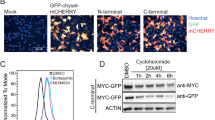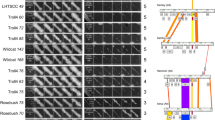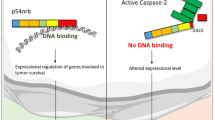Abstract
Omi is a mammalian serine protease that is localized in the mitochondria and released to the cytoplasm in response to apoptotic stimuli. Omi induces cell death in a caspase-dependent manner by interacting with the X-chromosome linked inhibitor of apoptosis protein, as well as in a caspase-independent way that relies on its proteolytic activity. Omi is synthesized as a precursor polypeptide and is processed to an active serine protease with a unique PDZ domain. PDZ domains recognize the extreme carboxyl terminus of target proteins. Internal peptides that are able to fold into a β-finger are also reported to bind some PDZ domains. Using a modified yeast two-hybrid system, PDZOmi mutants were isolated by their ability to bind the carboxyl terminus of human Myc oncoprotein in yeast as well as in mammalian cells. One such PDZm domain (PDZ-M1), when transfected into mammalian cells, was able to bind to endogenous Myc protein and induce cell death. PDZ-M1-induced apoptosis was entirely dependent on the presence of Myc protein and was not observed when c-myc null fibroblasts were used. Our studies indicate that the PDZ domain of Omi can provide a prototype that could easily be exploited to target specifically and inactivate oncogenes by binding to their unique carboxyl terminus.
This is a preview of subscription content, access via your institution
Access options
Subscribe to this journal
Receive 50 print issues and online access
$259.00 per year
only $5.18 per issue
Buy this article
- Purchase on Springer Link
- Instant access to full article PDF
Prices may be subject to local taxes which are calculated during checkout








Similar content being viewed by others
References
Adams ME, Butler MH, Dwyer TM, Peters MF, Murnane AA and Froehner SC . (1993). Neuron, 11, 531–540.
Aiyar A . (2000). Methods Mol. Biol., 132, 221–241.
Bezprozvanny I and Maximov A . (2001). FEBS Lett., 509, 457–462.
Blackwood EM, Luscher B and Eisenman RN . (1992). Genes Dev., 6, 71–80.
Bredt DS, Hwang PM, Glatt CE, Lowenstein C, Reed RR and Snyder SH . (1991). Nature, 351, 714–718.
Cho KO, Hunt CA and Kennedy MB . (1992). Neuron, 9, 929–942.
Daniels DL, Cohen AR, Anderson JM and Brunger AT . (1998). Nat. Struct. Biol., 5, 317–325.
Doyle DA, Lee A, Lewis J, Kim E, Sheng M and MacKinnon R . (1996). Cell, 85, 1067–1076.
Evan G, Harrington E, Fanidi A, Land H, Amati B and Bennett M . (1994). Philos. Trans. R. Soc. London Ser. B., 345, 269–275.
Faccio L, Chen A, Fusco C, Martinotti S, Bonventre JV and Zervos AS . (2000a). Am. J. Physiol. Cell. Physiol., 278, C781–C790.
Faccio L, Fusco C, Chen A, Martinotti S, Bonventre JV and Zervos AS . (2000b). J. Biol. Chem., 275, 2581–2588.
Faccio L, Fusco C, Viel A and Zervos AS . (2000c). Genomics, 68, 343–347.
Fanning AS and Anderson JM . (1996). Curr. Biol., 6, 1385–1388.
Fusco C, Guidotti E and Zervos AS . (1999). Yeast, 15, 715–720.
Gee SH, Quenneville S, Lombardo CR and Chabot J . (2000). Biochemistry, 39, 14638–14646.
Grandori C, Mac J, Siebelt F, Ayer DE and Eisenman RN . (1996). EMBO J., 15, 4344–4357.
Gray CW, Ward RV, Karran E, Turconi S, Rowles A, Viglienghi D, Southan C, Barton A, Fantom KG, West A, Savopoulos J, Hassan NJ, Clinkenbeard H, Hanning C, Amegadzie B, Davis JB, Dingwall C, Livi GP and Creasy CL . (2000). Eur. J. Biochem., 267, 5699–5710.
Gyuris J, Golemis E, Chertkov H and Brent R . (1993). Cell, 75, 791–803.
Hegde R, Srinivasula SM, Zhang Z, Wassell R, Mukattash R, Cilenti L, DuBois G, Lazebnik Y, Zervos AS, Fernandes-Alnemri T and Alnemri ES . (2002). J. Biol. Chem., 277, 432–438.
Hoskins R, Hajnal AF, Harp SA and Kim SK . (1996). Development, 122, 97–111.
Hu SI, Carozza M, Klein M, Nantermet P, Luk D and Crowl RM . (1998). J. Biol. Chem., 273, 34406–34412.
Hung AY and Sheng M . (2001). J. Biol. Chem., 10, 10.
Itoh M, Nagafuchi A, Yonemura S, Kitani-Yasuda T and Tsukita S . (1993). J. Cell. Biol., 121, 491–502.
Jesaitis LA and Goodenough DA . (1994). J. Cell. Biol., 124, 949–961.
Kalderon D, Roberts BL, Richardson WD and Smith AE . (1984). Cell, 39, 499–509.
Krojer T, Garrido-Franco M, Huber R, Ehrmann M and Clausen T . (2002). Nature, 416, 455–459.
Levchenko I, Smith CK, Walsh NP, Sauer RT and Baker TA . (1997). Cell, 91, 939–947.
Littlewood TD and Evan GI . (1990). Adv. Dent. Res., 4, 69–79.
Lue RA, Marfatia SM, Branton D and Chishti AH . (1994). Proc. Natl. Acad. Sci. USA, 91, 9818–9822.
Martins LM, Iaccarino I, Tenev T, Gschmeissner S, Totty NF, Lemoine NR, Savopoulos J, Gray CW, Creasy CL, Dingwall C and Downward J . (2002). J. Biol. Chem., 277, 439–444.
Mateyak MK, Obaya AJ, Adachi S and Sedivy JM . (1997). Cell Growth Differ., 8, 1039–1048.
Muller BM, Kistner U, Veh RW, Cases-Langhoff C, Becker B, Gundelfinger ED and Garner CC . (1995). J. Neurosci., 15, 2354–2366.
Pallen MJ and Wren BW . (1997). Mol. Microbiol., 26, 209–221.
Riefler GM and Firestein BL . (2001). J. Biol. Chem., 276, 48262–48268.
Ruff P, Speicher DW and Husain-Chishti A . (1991). Proc. Natl. Acad. Sci. USA, 88, 6595–6599.
Saras J and Heldin CH . (1996). Trends Biochem. Sci., 21, 455–458.
Schneider S, Buchert M, Georgiev O, Catimel B, Halford M, Stacker SA, Baechi T, Moelling K and Hovens CM . (1999). Nat. Biotechnol., 17, 170–175.
Schneider S, Buchert M and Hovens CM . (1996). Biotechniques, 20, 960–962.
Sheng M and Sala C . (2001). Annu. Rev. Neurosci., 24, 1–29.
Solomon DL, Amati B, Land H . (1993). Nucleic Acids Res., 21, 5372–5376.
Songyang Z, Fanning AS, Fu C, Xu J, Marfatia SM, Chishti AH, Crompton A, Chan AC, Anderson JM and Cantley LC . (1997). Science, 275, 73–77.
Spiess C, Beil A and Ehrmann M . (1999). Cell, 97, 339–347.
Stone J, de Lange T, Ramsay G, Jakobovits E, Bishop JM, Varmus H and Lee W . (1987). Mol. Cell Biol., 7, 1697–1709.
Suzuki Y, Imai Y, Nakayama H, Takahashi K, Takio K and Takahashi R . (2001). Mol. Cell, 8, 613–621.
Vaccaro P, Brannetti B, Montecchi Palazzi L, Philipp S, Helmer Citterich M, Cesareni G and Dente L . (2001). J. Biol. Chem., 16, 16.
Verhagen AM, Silke J, Ekert PG, Pakusch M, Kaufmann H, Connolly LM, Day CL, Tikoo A, Burke R, Wrobel C, Moritz RL, Simpson RJ and Vaux DL . (2002). J. Biol. Chem., 277, 445–454.
Willott E, Balda MS, Fanning AS, Jameson B, Van Itallie C and Anderson JM . (1993). Proc. Natl. Acad. Sci. USA, 90, 7834–7838.
Woods DF and Bryant PJ . (1991). Cell, 66, 451–464.
Zervos AS, Gyuris J and Brent R . (1993). Cell, 72, 223–232.
Zumbrunn J and Trueb B . (1996). FEBS Lett., 398, 187–192.
Acknowledgements
We are grateful to members of the Zervos' lab and L Von Kalm for comments, suggestions and critical reading of the manuscript. This work was supported by the National Institutes of Health Grant R01 DK55734-01 (to ASZ).
Author information
Authors and Affiliations
Corresponding author
Rights and permissions
About this article
Cite this article
Junqueira, D., Cilenti, L., Musumeci, L. et al. Random mutagenesis of PDZOmi domain and selection of mutants that specifically bind the Myc proto-oncogene and induce apoptosis. Oncogene 22, 2772–2781 (2003). https://doi.org/10.1038/sj.onc.1206359
Received:
Revised:
Accepted:
Published:
Issue Date:
DOI: https://doi.org/10.1038/sj.onc.1206359



